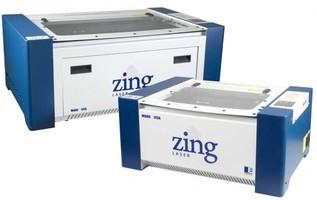The ABCs of Laser Cutters

Thursday, October 4, 2018
The start of the school year is the perfect time for anyone considering a laser cutter to learn the foundations of this exciting technology.
Just as they are in makerspaces and fab labs, laser cutters are one of the most versatile tools one can have in a classroom. They can cut patterns or pieces for final assembly; they can cut through a range of materials with high precision; and they are easy to use. All of those qualities rolled into one piece of technology make the laser cutter a very powerful piece of equipment — and a great investment for schools, businesses and entrepreneurs alike. When first starting out, here are a few tips to bear in mind:
- Select your materials carefully. A laser cutter uses a laser beam that is fired to allow any shape or design to be cut out of a flat piece of material; possibilities include plastic, wood, fabric, leather and more. Lasers are able to penetrate hard and thick materials that traditional drag-knife devices, such as craft cutters and vinyl cutters, cannot. There are, however, some materials that are not recommended for use with a laser — such as anything containing polyvinyl chloride (PVC). This material is not only very messy to engrave or cut on a laser, but can also release a corrosive gas that is harmful to both the inner workings of the laser system and the laser operator. If you’re ever unsure whether a material includes PVC as one of its components, you can request a material safety data sheet (MSDS) from the manufacturer. Most other materials are laser compatible, but flare-ups can occasionally happen, especially when cutting acrylics. That’s why it’s of paramount importance never to leave the laser unattended.
- Take safety seriously. While even elementary schoolchildren can use laser cutters when properly supervised, it’s important to remember that these are tools, not toys. Filtration systems are needed, because the fumes and dust caused by etching can be toxic. Fire extinguishers are also recommended to combat flare-ups. Epilog recommends a Halotron fire extinguisher or a multi-purpose dry chemical fire extinguisher. Of these two options, the Halotron extinguisher is more expensive option, but offers advantages such as the discharge of a clean, easily removable substance that is not harmful to the mechanics or wiring of the laser system. The dry chemical extinguisher, by contrast, discharges a sticky, corrosive powder that can be very difficult to clean up.
- Create a plan to guide your equipment choices. Having a solid understanding of your needs and a business purpose outline will allow you not only to create a great budget proposal for buying or leasing a laser cutter — it will also guide you in selecting the best model. System cost is determined by factors such as motor type (stepper or servo); engraving table size; and laser wattage, which ranges from 30 watts to 120 watts. An entry-level cutter might have an engraving bed measuring 16 in x 12 in, which could be ideal for a classroom or startup; a new, entry-level 30 watt system costs less than $8,000. An enterprise-size business, by contrast, may need machinery on the opposite side of the spectrum — with features such as a 40 in x 28 in engraving bed, 120 watts of power and a price tag closer to $42,000.
There is no question that a laser cutter can be an invaluable tool for growing a business or expanding a school curriculum, opening new markets and providing insight into a potential career path. Laser systems can help companies and schools alike blaze new pathways to success.
Contact Epilog Laser for more information on their laser products.
Source: www.epiloglaser.com[/vc_column_text][/vc_column][/vc_row]









 This content was provided by Epilog Laser. In business since 1988, Epilog Laser has worked hard to become the leader in the laser engraving, cutting and marking industry. We are innovators. We are problem solvers. We are committed to designing and manufacturing the highest-quality laser systems, right here in our Golden, CO headquarters.
This content was provided by Epilog Laser. In business since 1988, Epilog Laser has worked hard to become the leader in the laser engraving, cutting and marking industry. We are innovators. We are problem solvers. We are committed to designing and manufacturing the highest-quality laser systems, right here in our Golden, CO headquarters.








